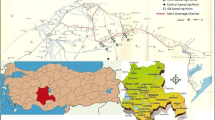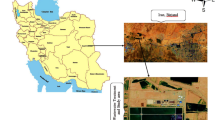Abstract
Treated industrial effluents have high levels of nutrients and dissolved organic matter. The irrigation of rice by flooding can increase nutrient uptake and grain yield. Therefore, this study evaluated the nutrient contents in the shoots and grain of the rice crop and also the chemical of the soil after irrigation of the crop with leachate of the treated industrial effluent. A greenhouse experiment was conducted using pots filled with 20 kg of soil in a randomized block design with three replications. The treatments consisted of control (irrigation with distilled water) and four concentrations of the leachate (25, 50, 75, and 100 %) for irrigation. At the end of the experiment, the nutrient contents in tissues of rice plants, sterility of spikelets, and grain mass were evaluated. Results showed that irrigation with the leachate at 25 % content increased the macro- and micronutrients’ concentrations in the shoot biomass and grain, except for potassium and iron. Irrigation with the industrial leachate decreased tillering and grain yield; however, it increased chlorophyll content, sterility of spikelets, and sodium intake at this leachate concentration. The potassium and sodium levels and the electrical conductivity values of soils irrigated with treated industrial leachate were increased. The use of the treated leachate from industrial effluents is an alternative that reuses the nutritional load, but the volume of leachate should be limited and monitored to prevent the sodicity in the soil and problemsdue to eutrophication.




Similar content being viewed by others
References
Blum J, Melfi JA, Montes CR, Gomes T (2013) M. Nitrogen and phosphorus leaching in a tropical Brazilian soil cropped with sugarcane and irrigated with treated sewage effluent. Agric Water Manage 117:115–122. doi:10.1016/j.agwat.2012.11.010
Carlos FS, Giovanella P, Bavaresco J, Borges CS, Camargo FAO (2016) A comparison of microbial bioaugmentation and biostimulation for hexavalent chromium removal from wastewater. Water Air Soil Pollut 227:175. doi:10.1007/s11270-016-2872-5
Carlos FS, Marafon AJ, Andreazza R, Anghinoni I, Tedesco MJ (2015) Camargo FAO Electrochemical changes and nutrient dynamics in the soil solution cultivated with rice treated industrial leached. R Bras Ci Solo 39:466–474. doi:10.1590/01000683rbcs20140127
Carmona FC, Anghinoni I, Holzschuh MJ, Martins AP (2011) Attributes of irrigated rice as affected by soil sodicity and potassic fertilizer application. R Bras Ci Solo 35:889–897. doi:10.1590/S0100-06832011000300023
Castillo EG, Tuong TP, Ismail AM, Inubushi K (2007) Response to salinity in rice: Comparative effects of osmotic and ionic stresses. Plant Prod Sci 10:159–170. doi:10.1626/pps.10.159
Chavez A, Rodas K, Prado B, Thompson R, Jimenez B (2012) An evaluation of theeffects of changing wastewater irrigation regime for the production of alfalfa (Medicago sativa). Agric Water Manage 113:76–84. doi:10.1016/j.agwat.2012.06.021
Christofidis D (2001) Water resources and the practice of irrigation in Brazil and in the world. Irrig Tec Mod 49:8–13
Conley DJ, Paerl HW, Howarth RW, Boesch DF, Seitzinger SP, Havens KE, Lancelot C, Likens GE (2009) Controlling Eutrophication: Nitrogen and Phosphorus. Science 323:1014–1015. doi:10.1126/science.1167755
Corcoran E, Nellemann C, Baker E, Bos R, Osborn D, Savelli H (2010) SickWater? The central role of wastewater management in sustainable develop-ment. A Rapid Response Assessment. United Nations Environment Programme,UN-HABITAT, GRID-Arendal
CQFS-RS/SC – Chemistry Commission and Soil Fertility in the states of Rio Grande do Sul and Santa Catarina (2004) Manual fertilization and liming to the states of Rio Grande do Sul and Santa Catarina, Brazil. 10. ed. Porto Alegre
Drechel P, Scott CA, Rachid L, Redwood M, Bahri A (2010) Wastewater Irrigation and Health. Earthscan, London
Falkiner RA, Smith CJ (1997) Changes in soil chemistry in effluent-irrigated Pinus radiata and Eucalyptus grandis. Aust J Soil Res 35:131–147. doi:10.1071/S95080
Fepam - State Environmental Protection Foundation Henrique Roessler (2001) Diagnosis of water pollution in the river basin of the Guaíba, Porto Alegre
Fonseca AF, Melfi AJ, Montes CR (2005) Maize growth and changes in soil fertility after irrigation with treated sewage effluent. in soil acidity, exchangeable cations, and sulfur, boron and heavy metals availability. Commun Soil Sci Plant Anal 36:1983–2003. doi:10.1081/CSS-200062542
Fonseca AF, Herpin U, Paula AM, Victoria RL, Melfi AJ (2007) Agricultural use of treated sewage effluents: agronomical–environmental implications and perspectives for Brazil. Sci Agric 64:194–209. doi:10.1590/S0103-90162007000200014
Ghiberto PJ, Libardi PL, Brito AS, Trivelin PCO (2009) Leaching of nutrients from a sugarcane crop growing on an Ultisol in Brazil. Agric Water Manage 96:1443–1448. doi:10.1016/j.agwat.2009.04.020
Gonçalves GK, Meurer EJ (2010) Phosphorus concentration changes in soils under flooded rice in Rio Grande do Sul, Brazil. R Bras Ci Solo 34:465–472. doi:10.1590/S0100-06832010000200020
Gonçalves GK, Meurer EJ, Bortolon L, Gonçalves DRN (2011) Relationship between iron oxides and manganese and phosphorus sorption in soils in Rio Grande do Sul, Brazil. R Bras Ci Solo 35:1633–1639. doi:10.1590/S0100-06832011000500017
Grattan SR, Zeng L, Shannon MC, Roberts SR (2002) Rice is more sensitive to salinity than previously thought. Calif Agric 56:189–195. doi:10.3733/ca.v056n06p189
Halliwell DJ, Barlow KM, Nash DM (2001) A review of the effects of wastewater sodium on soil physical properties and their implications for irrigation systems. Aust J Soil Res 39:1259–1267. doi:10.1071/SR00047
Hamilton AJ, Stagnitti F, Xiong X, Kreidl SL, Benke KK, Maher P (2007) Wastewater irrigation: the state of play. Vadose Zone J 6:823–840. doi:10.2136/vzj2007.0026
Herpin U, Gloaguen TV, Fonseca AF, Montes CR, Mendonça FC, Piveli RP, Breulmann G, Forti MC, Melfi AJ (2007) Chemical effects on the soil-plant system in a secondary treated wastewater irrigated coffee plantation - a pilot field study in Brazil. Agric Water Manage 89:105–115. doi:10.1016/j.agwat.2007.01.001
Hespanhol I (2002) Water reuse potential in Brazil - agriculture, industry, municipalities and aquifer recharge. R Brasi Rec Hídric 7:75–95
IBGE - Brazilian institute of geography and statistics (2010) Sustainable development indicator. Studies and research - Information Geographic. N. 7, Rio de Janeiro
IRRI - International Rice Research Institute (2015). Rice Facts. Available at http://irri.org. Accessed 24 August 2015
Jang TI, Jung MP, Lee EJ, Park SW, Lee JH (2013) Assessing environmentalimpacts of reclaimed wastewater irrigation in paddy fields using bioindicator. Irrig Sci 31:1225–1236. doi:10.1007/s00271-013-0401-5
Jeong H, Jang T, Seong C, Park S (2014) Assessing nitrogen fertilizer rates and split applications using the DSSAT model for rice irrigated with urban wastewater. Agric Water Manage 141:1–9. doi:10.1016/j.agwat.2014.04.009
Kirk GJD (2001) Plant-mediated processes to acquire nutrients: Nitrogen uptake by rice plants. Plant Soil 232:129–134. doi:10.1023/A:1010341116376
Leal RMP, Herpin U, Fonseca AF, Firme LP, Montes CR, Melfi AJ (2009) Sodicity and salinity in a Brazilian oxisol cultivated with sugarcane irrigated with wastewater. Agric Water Manage 96:307–316. doi:10.1016/j.agwat.2008.08.009
Levy GJ, Pinchas F, Bar-Tel A (2011) Treated Wastewater in Agriculture: Use and Impacts on Soil Environment and Crops. Wiley-Blackwell, West Sussex, UK
Melo PCS, Anunciação Filho CJ, Oliveira FJ, Bastos GQ, Tabosa JN, Santos VF, Melo MRCS (2006) Selection of rice genotypes tolerant to salinity in germination phase. Ci Rural 36:58–64. doi:10.1590/S0103-84782006000100009
Munns R (2002) Comparative physiology of salt and water stress. Plant, Cell Environ 25:239–250. doi:10.1046/j.0016-8025.2001.00808.x
Naidu R, Rengasamy P (1993) Ion Interactions and constraints to plant nutrition in Australian sodic soils. Aust J Soil Res 31:801–819. doi:10.1071/SR9930801
Oster JD, Shainberg I (2001) Soil responses to sodicity and salinity: challenges and opportunities. Aust J Soil Res 39:1219–1224. doi:10.1071/SR00051
Pedrero F, Kalavrouziotis I, Alarcón JJ, Koukoulakis P, Asano T (2010) Use of treated municipal wastewater in irrigated agriculture. Review of some practices in Spain and Greece. Agric Water Manage 97:1233–1241. doi:10.1016/j.agwat.2010.03.003
Pereira BFF, He ZL, Silva MS, Herpin U, Nogueira SF, Montes CR, Montes CR, Melfi AJ (2011) Reclaimed wastewater: impact on soil–plant system under tropical conditions. J Haz Materials 192:54–61. doi:10.1016/j.jhazmat.2011.04.095
Ponnamperuma FN (1972) The chemistry of submerged soils. Adv Agron 24:29–96
Richards LA (1954) Diagnosis and improvement of saline and alkali soils. United States Salinity Laboratory, Agricultural Handbook, Washington
Rodrigues LN, Fernandes PD, Gheyi HR, Nery AR, Correia KG (2005) Rice production in saline conditions using seedlings produced with and without saline stress. R Bras Eng Agric Ambi 9:95–100
SAS-Statistical Analyses System (2008) Statistical Analysis System user’s guide. Version 9.2. Cary: Statistical Analyses System Institute
Sosbai - South Brazilian Society of Irrigated Rice (2014) Technical Research Recommendations for the South Brazil. Technical Meeting of the Irrigated Rice Culture, Bento Gonçalves, Brazil
Streck EV, Kämpf N, Dalmolin RSD, Klamt E, Nascimento PC, Schneider P, Giasson E, Pinto LFS (2008) Soils of the Rio Grande do Sul 2.ed. Porto Alegre, Brazil
Tedesco MJ, Gianello C, Bissani CA, Bohnen H, Volkweiss SJ (1995) Analysis of soil, plants and other materials, Department of Soils. Federal University Rio grande do Sul, Porto Alegre, Brazil
Yadav RK, Goyal B, Sharma RK, Dubey SK, Minhas PS (2002) Post-irrigation impact of domestic sewage effluent on composition of soils, crops and ground water - a case study. Environ Int 28:481–486. doi:10.1016/S0160-4120(02)00070-3
Acknowledgments
The authors wish to thank CNPq and CAPES for the fund support and scholarships provided. The authors also wish to thank UTRESA, especially João Bombarda who provided the leachate and the support needed to conduct the experiment.
Author information
Authors and Affiliations
Corresponding author
Rights and permissions
About this article
Cite this article
Carlos, F.S., dos Santos, B.L., Andreazza, R. et al. Irrigation of paddy soil with industrial landfill leachate: impacts in rice productivity, plant nutrition, and chemical characteristics of soil. Paddy Water Environ 15, 133–144 (2017). https://doi.org/10.1007/s10333-016-0535-1
Received:
Revised:
Accepted:
Published:
Issue Date:
DOI: https://doi.org/10.1007/s10333-016-0535-1




